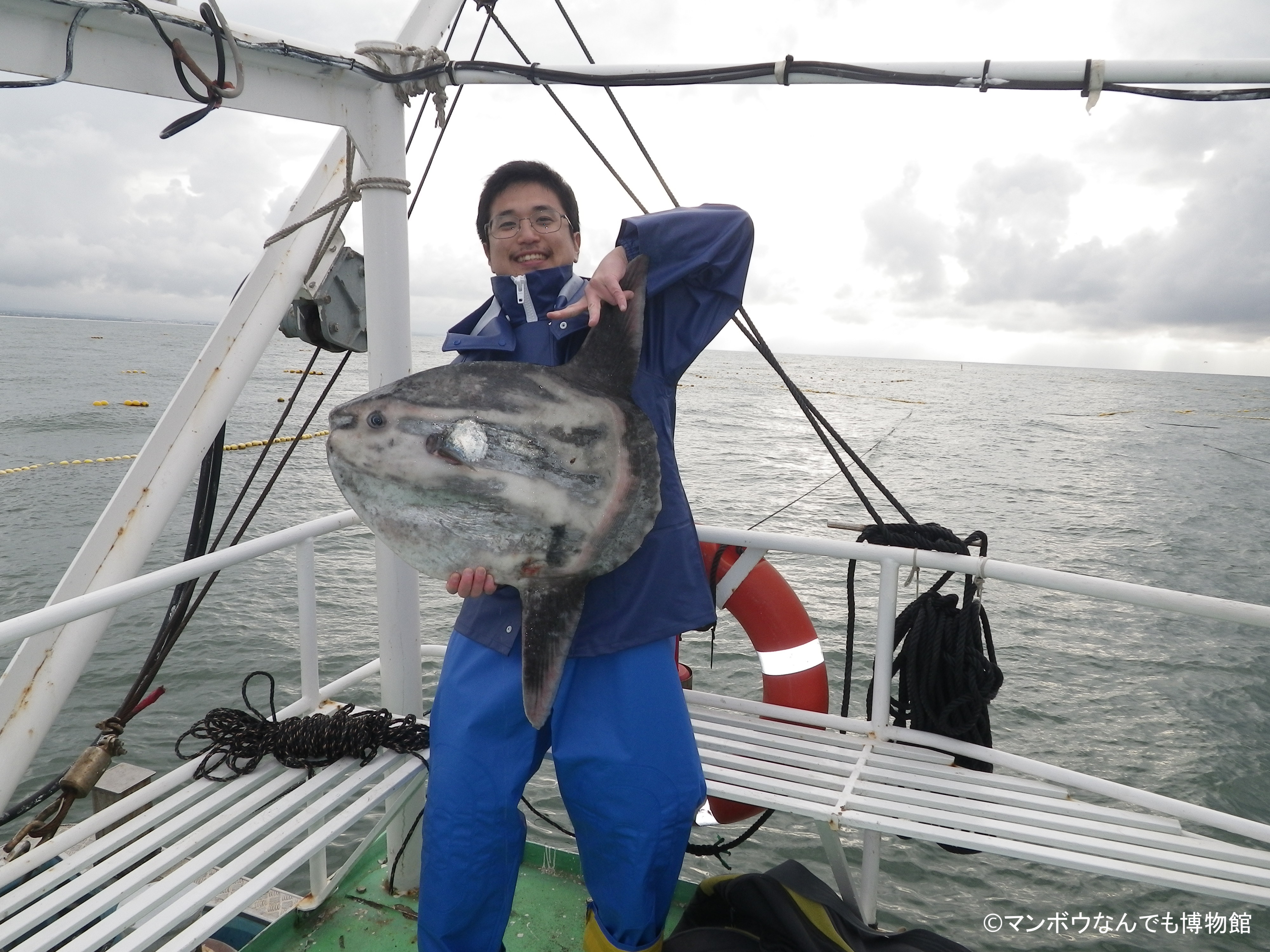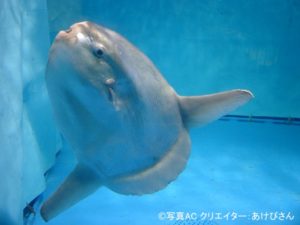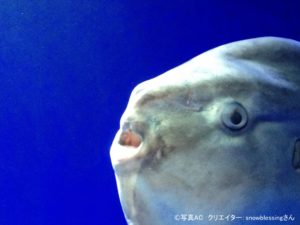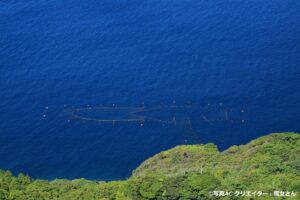【執筆者 澤井悦郎】
深海魚とは、水深200m以深(一般的な深海の定義)に生息する魚類の総称である。
リュウグウノツカイは深海魚の代表格であるが、以前から水面付近でも時折目撃されている。表層で見られても深海魚と言えるのならば、逆説的に、毎日のように深海まで潜っているマンボウ類も深海魚と言っても過言ではないだろう。実際、深海魚の定義は結構曖昧である。
マンボウ類は水面でプカプカと浮かんでいるイメージを持たれている方は多いが、バイオロギングなどの行動研究によって実際は結構深海まで潜ることがわかってきた。ここでは各論文で記録された各最大潜水深度を紹介しよう。
マンボウ科と潜水記録の歴史
〝マンボウ Mola mola〟として書かれている論文は、分類学的再検討が行われる前はマンボウ属3種のどの種かわからないものがある。それらの論文はここでは属レベルで示した。
「〜前後」と書いてるのは論文の図からのおおまかな数値の読み取りである。
- ヤリマンボウ 水深670m(Harbison & Janssen, 1987)
- ヤリマンボウ 水深850m前後(Seitz et al., 2002)
- マンボウ属 水深392m(Cartamil & Lowe, 2004)
- 〝マンボウ〟水深144m(Watanabe & Sato, 2008)(※サイト主研究協力)
- マンボウ属 水深472m(Sims et al., 2009)
- マンボウ属 水深525m(Hays et al., 2009)
- マンボウ属 水深80m前後(Houghton et al., 2009)
- 〝マンボウ〟水深644m(Dewar et al., 2010)(※日本近海で全長133cm以下のウシマンボウは稀なのでおそらく〝マンボウ〟)
- マンボウ属 水深844m(Potter & Howell, 2011)
- 〝マンボウ〟水深170m前後(Nakamura & Sato, 2014)(※日本近海で全長164cm以下のウシマンボウは稀なのでおそらく〝マンボウ〟)
- 〝マンボウ〟水深240m前後(Nakamura et al., 2015)(※日本近海で全長200cm以下のウシマンボウは稀なのでおそらく〝マンボウ〟)
- ウシマンボウ 水深540m前後(Thys et al., 2016)
- マンボウ属 水深704m(Sousa et al., 2016)
- ウシマンボウ 水深1112m(Thys et al., 2017)
- ヤリマンボウ 水深300m前後(中村,2017)
- 〝マンボウ〟 水深602m(Chang et al., 2019仮)(※論文の写真から〝マンボウ〟と同定)
- ウシマンボウ 水深220m(Sawai & Yamada, 2020)
マンボウ科最深記録
現状、マンボウ科の中での最深記録はウシマンボウの水深1112m(Thys et al., 2017)である。これだけ深く潜れるのにマンボウ類が深海魚じゃないとは言わせない。
ここに載っていないカクレマンボウとクサビフグは一体どこまで深く潜るのか・・・今後の研究成果が楽しみである。ちなみに、Sawai & Yamada(2020)の論文は野口(2020)のニュースに取り上げて頂いたので、合わせてご覧いただきたい。
参考文献
Cartamil DP, Lowe, CG. 2004. Diel movement patterns of ocean sunfish Mola mola off southern California. Marine Ecology Progress Series, 266: 245-253.
Chang C-T, Lin S-J, Chiang W-C, Musyl KM, Lam CH, Hsu H-H, Chang Y-C, Ho Y-S, Tseng C-T. 2019(仮). Horizontal and vertical movement patterns of sunfish off eastern Taiwan. Deep Sea Research Part II: Topical Studies in Oceanography, xx: xx-xx.
Dewar H, Thys T, Teo SLH, Farwell C, O’Sullivan J, Tobayama T, Soichi M, Nakatsubo T, Kondo Y, Okada Y, Lindsay DJ, Hays GC, Walli A, Weng K, Streelman JT, Kari SA. 2010. Satellite tracking the world’s largest jelly predator, the ocean sunfish, Mola mola, in the Western Pacific. Journal of Experimental Marine Biology and Ecology, 393: 32-42.
Harbison GR, Janssen J. 1987. Encounters with a swordfish (Xiphias gladius) and sharptail mola (Masturus lanceolatus) at depths greater than 600 meters. Copeia, (2): 511-513.
Hays GC, Farquhar MR, Luschi P, Teo SLH, Thys TM. 2009. Vertical niche overlap by two ocean giants with similar diets: oceanic sunfish and leatherback turtles. Journal of Experimental Marine Biology and Ecology, 370: 134-143.
Houghton JDR, Liebsch N, Doyle TK, Gleiss A, Lilley MKS, Wilson RP, Hays GC. 2009. Harnessing the sun: testing a novel attachment method to record fine scale movements in ocean sunfish (Mola mola). pp. 229-242. In: Nielsen JL, Arrizabalaga H, Fragoso N, Hobday A, Lutcavage M, Sibert J (eds) Tagging and tracking of marine animals with electronic devices, vol 9. Springer, Dordrecht.
中村乙水.2017.台湾ヤリマンボウ.日本バイオロギング研究会会報,(135): 2-3.
Nakamura I, Goto Y, Sato K. 2015. Ocean sunfish rewarm at the surface after deep excursions to forage for siphonophores. Journal of Animal Ecology. 84: 590-603.
Nakamura I, Sato K. 2014. Ontogenetic shift in foraging habit of ocean sunfish Mola mola from dietary and behavioral studies. Marine Biology, 161: 1263-1273.
野口みな子.2020.マンボウ、驚きの潜水能力 「最弱伝説」を否定する新たな事実が!.withnews.2020年2月7日.
Potter IF, Howell WH. 2011. Vertical movement and behavior of the ocean sunfish, Mola mola, in the northwest Atlantic. Journal of Experimental Marine Biology and Ecology, 396: 138-146.
Sawai E, Yamada M. 2020. Bump-head sunfish Mola alexandrini photographed in the north-west Pacific Ocean mesopelagic zone. Journal of Fish Biology, 96: 278-280.
Seitz AC, Weng KC, Boustany AM, Block BA. 2002. Behaviour of a sharptail mola in the Gulf of Mexico. Journal of Fish Biology, 60: 1597-1602.
Sims DW, Queiroz N, Doyle TK, Houghton JDR, Hays, GC. 2009. Satellite tracking of the world’s largest bony fish, the ocean sunfish (Mola mola L.) in the North East Atlantic. Journal of Experimental Marine Biology and Ecology, 370: 127-133.
Sousa LL, Queiroz N, Mucientes G, Humphries NE and Sims DW. 2016. Environmental influence on the seasonal movements of satellite-tracked ocean sunfish Mola mola in the north-east Atlantic. Animal Biotelemetry, 4: 7.
Thys TM, Hearn AR, Weng KC, Ryan JP, Peñaherrera-Palma C. 2017. Satellite tracking and site fidelity of short ocean sunfish, Mola ramsayi, in the Galapagos Islands. Journal of Marine Biology, 2017: 7097965.
Thys T, Ryan JP, Weng KC, Erdmann M, Tresnati J. 2016. Tracking a Marine Ecotourism Star: Movements of the short ocean sunfish Mola ramsayi in Nusa Penida, Bali, Indonesia. Journal of Marine Biology. 2016:1-6.
Watanabe Y, Sato K. 2008. Functional dorsoventral symmetry in relation to lift-based swimming in the ocean sunfish Mola mola. PLoS ONE 3 (10), e3446.
更新履歴
- サイトデザイン一新に伴いリライト(2023年6月19日)
- 更新履歴の表示方法をアコーディオンボックスの仕様を変更(2021年6月27日)
作成日:2020年7月18日 更新日:2023年6月19日












